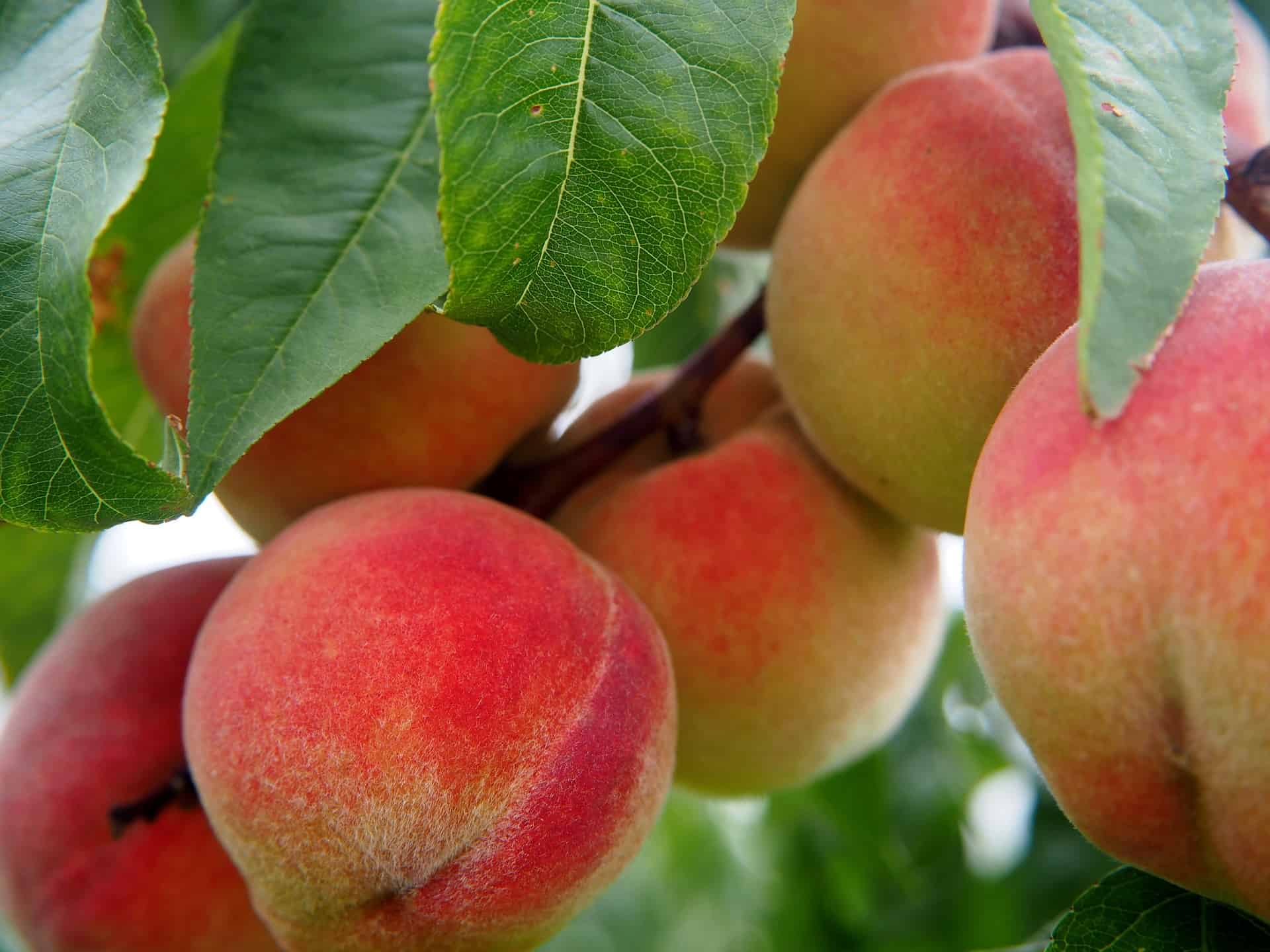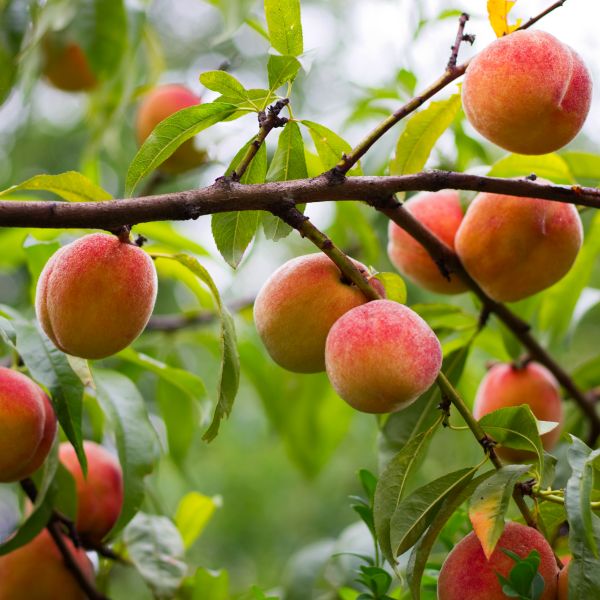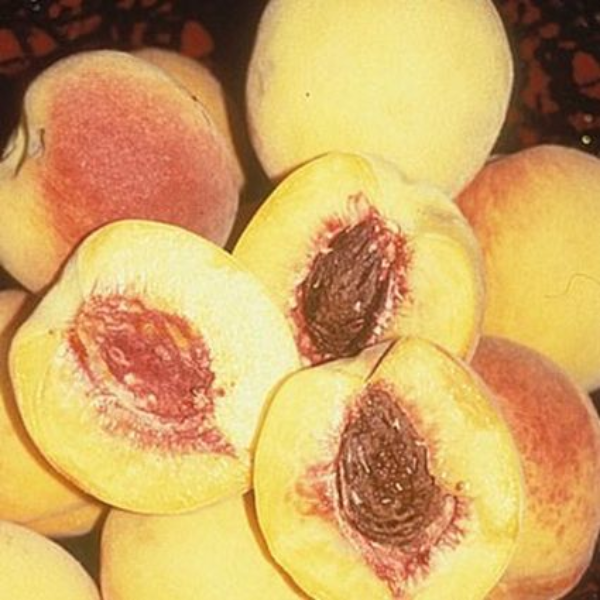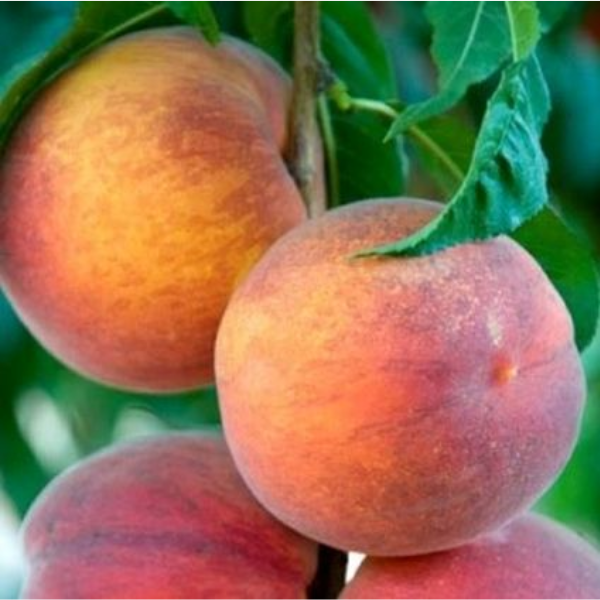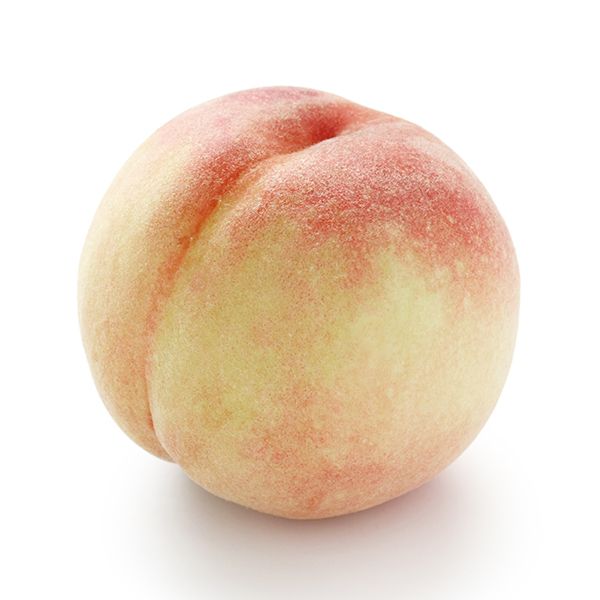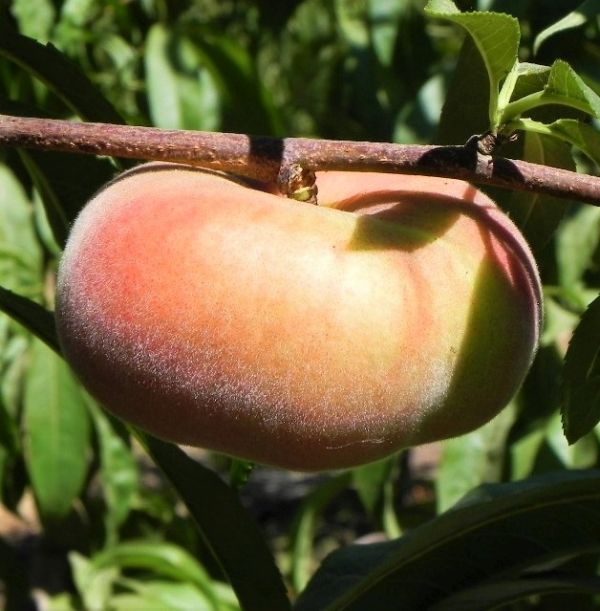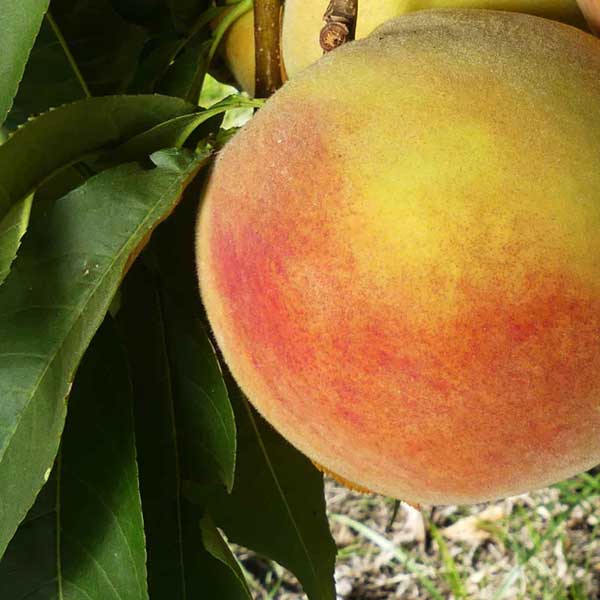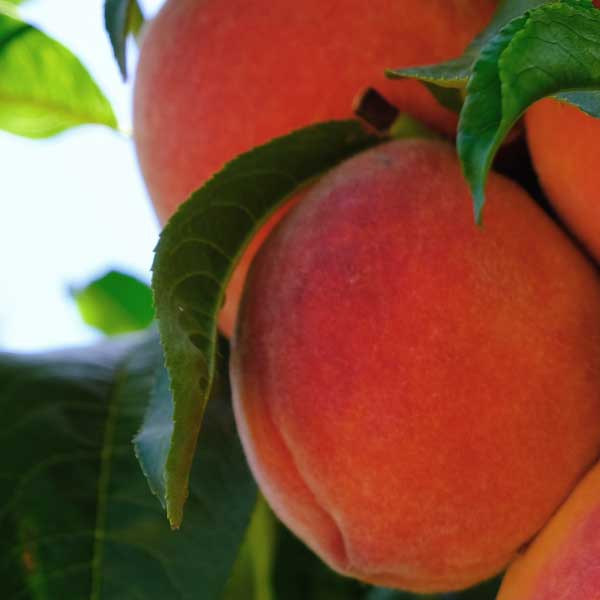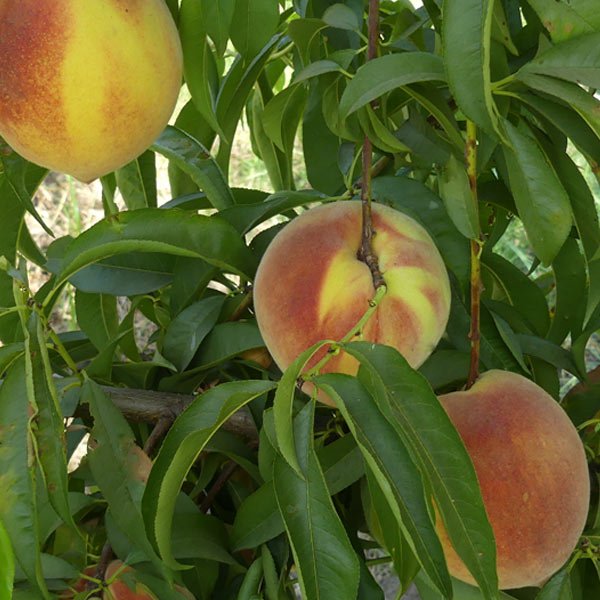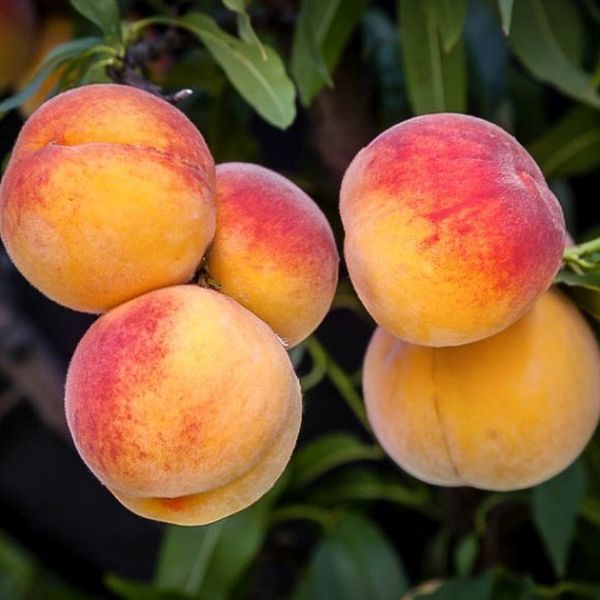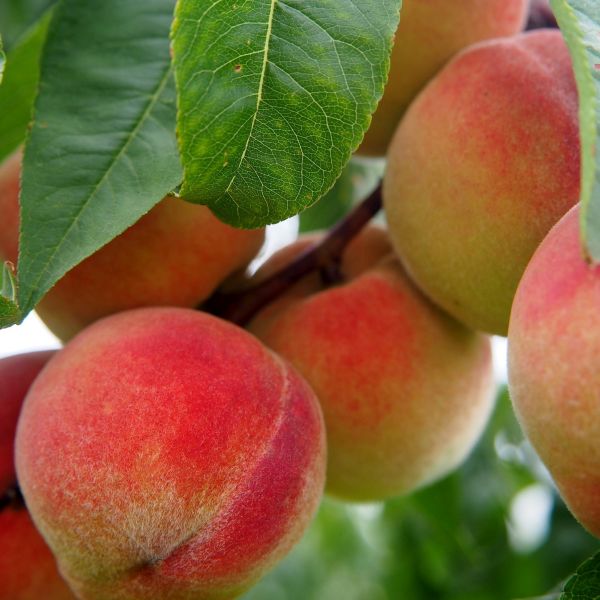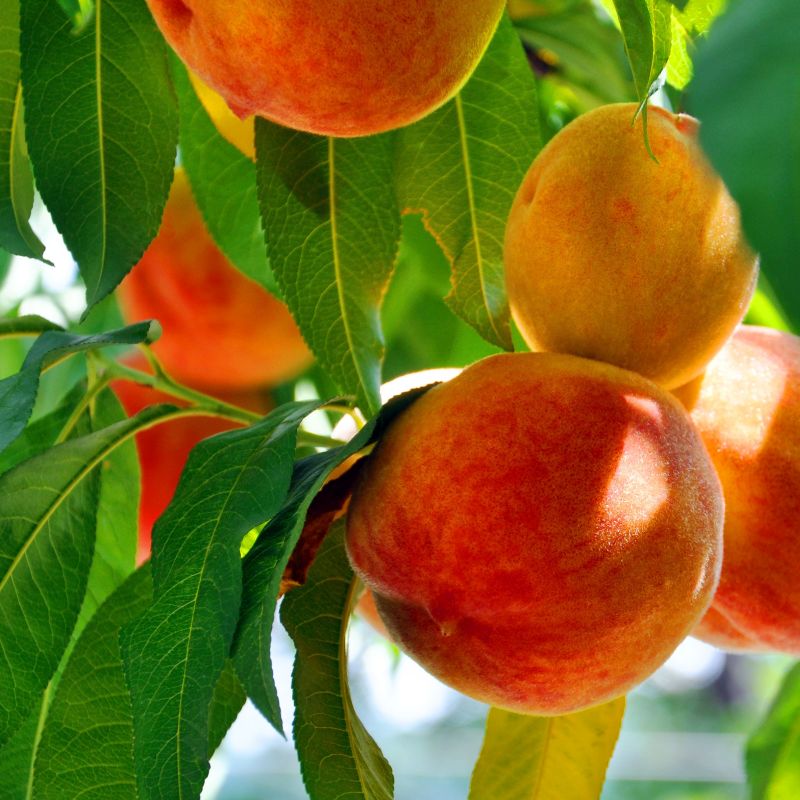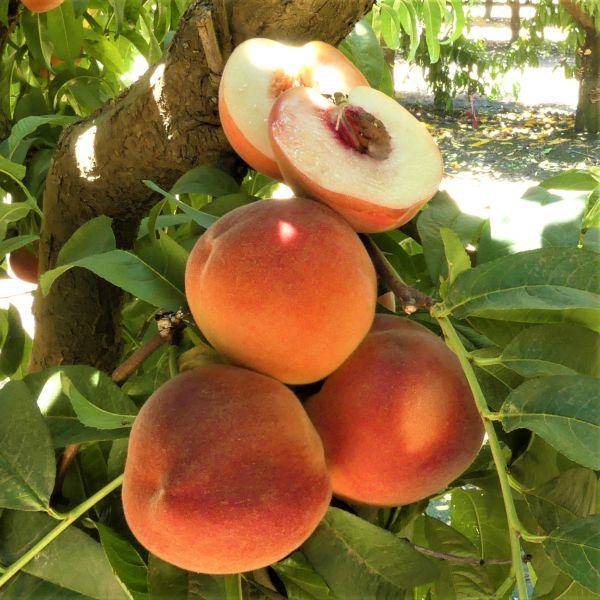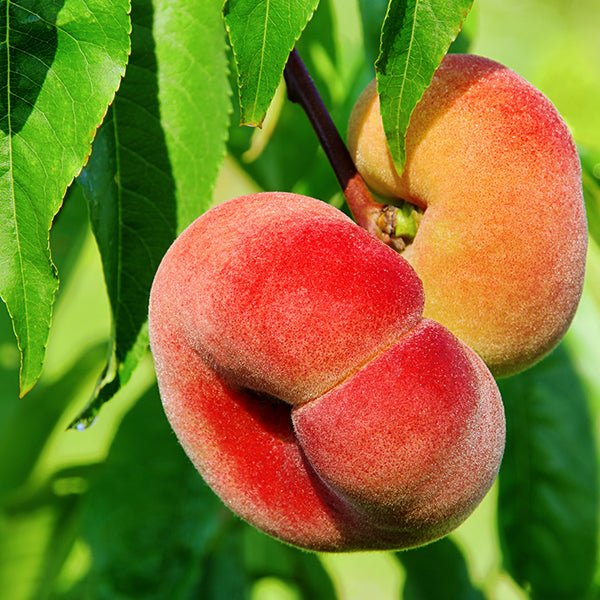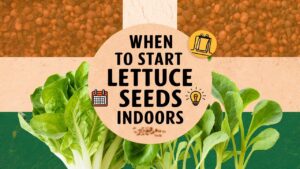There are so many different Peach Tree Varieties that you can grow in your garden. You’ll even find some cold-tolerant types of peach trees in this list that can set fruit in areas that experience late spring frosts.
Peach Tree Varieties
Contender Peach Tree
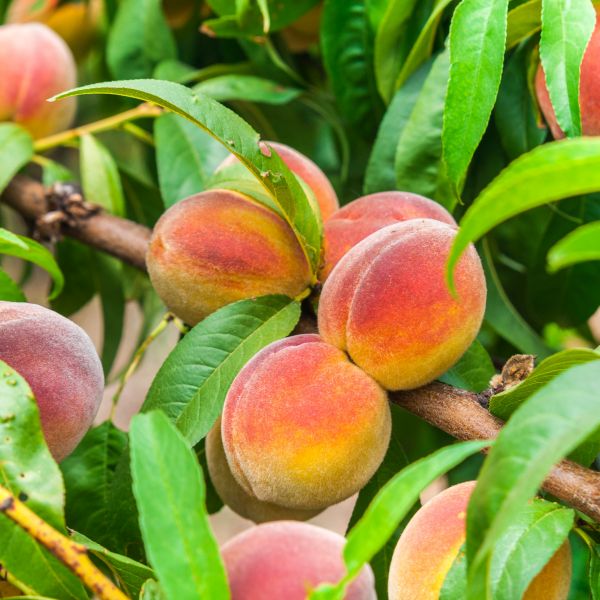
Contender Peach Tree – (Buy Online)
Contender Peach, Prunus persica ‘Contender’, is the first Peach tree for the home gardener that will survive in the North. This Peach will thrive where temperatures fall well below zero. Contender is an exceptionally hardy tree that will reliably give you loads of big, sweet, juicy fruit. It constantly wins for flavor at taste trials, so we know it will win for taste at your home!
To top it off, the trees are disease-resistant and self-pollinating. Even though the fruit is the main thing, they are also very beautiful trees in the garden. In the spring they are covered in pink flowers that attract butterflies and bees. They are sized just right for home gardens, too. Staying smaller and easy to reach, Contender will fit into any garden, large or small.
Red Baron Peach Tree
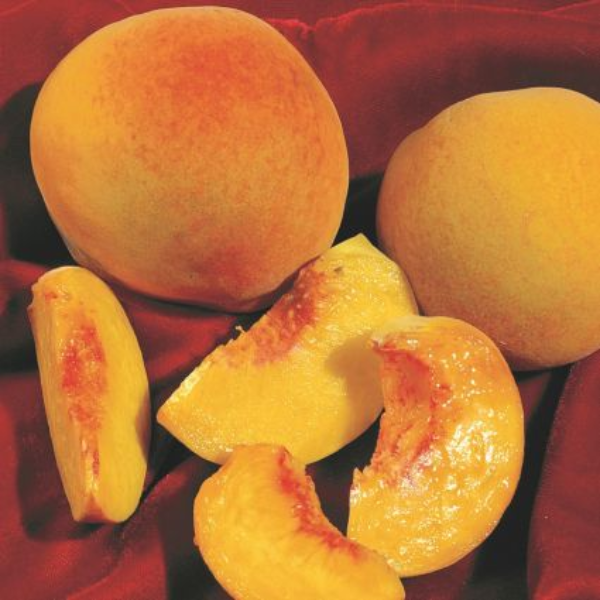
Red Baron Peach Tree – (Buy Online)
The Red Baron Peach Tree is like two trees in one, putting on a show you’ll come to treasure year-after-year. For its first act, Red Baron Peach tree puts on a spring display like no other when April finds it awash in stunning, scarlet blossoms. Each double flower is a picture of frilly, floral perfection that maintains its dazzling, bright red display for several weeks (and certainly earns its name of “Red Baron”). For its second act, Red Baron provides some of the best peaches you’ll ever taste. The 3-inch, firm globes of juicy peaches are so prolific that you’ll need to thin a few out each year.
Each freestone peach is brilliantly dressed in a sunny, yellow skin with splashes of red. The flesh is yellow and sweet with slight tart overtones for a deep, rich flavor you’ll come to crave. In fact, your Red Baron Peach tree scores high on taste tests for its superior flavor. It’s an August harvest you’ll never forget!
The Red Baron Peach tree is fast-growing so you won’t have to wait long to see results, and it’s relatively easy to care for. The Red Baron Peach tree doesn’t mind a little pruning, so it can be trimmed to a smaller size if you should prefer to keep it more petite for easy picking. It’s self-fruitful so you won’t have to plant a pollinator to ensure a harvest.
Hale Haven Peach Tree
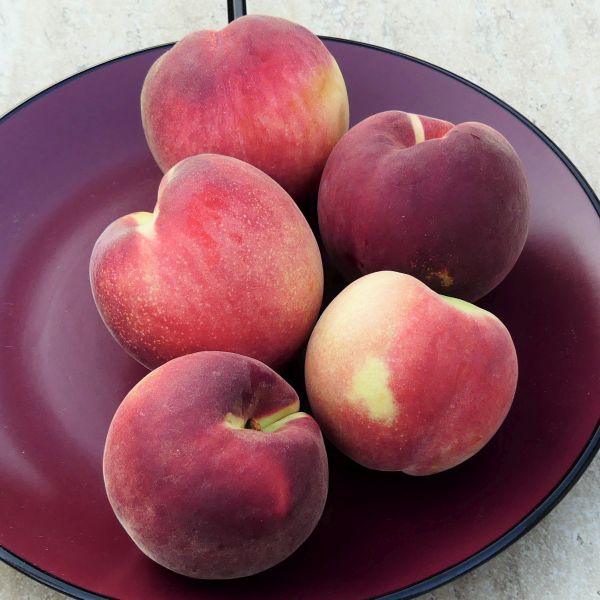
Hale Haven Peach Tree – (Buy Online)
Hale Haven is beloved for its sweet, melting yellow flesh that is able to withstand freezing, as well. Get ready to live your best life with wonderful homemade pies and preserves in February! With a durable skin that prevents bruising, These peaches have a freestone pit, which pulls away cleanly and easily. People in many parts of the country are seeking out ways to increase their food security. Even for beginners, growing disease-resistant
Hale Haven is a very popular variety for home orchards. Use a single tree as a pretty addition to your landscaping. Just get ready to start answering questions from any curious (and jealous!) passers-by. Hale Haven grows into a naturally rounded shape. It’s attractive from the pink spring bloom to the magnificent harvest and even golden-yellow fall color. Extend your harvest season by planting an early and late season variety along with the Hale Haven. Add a fun, great-tasting Donut Peach, or a sweet, white-fleshed variety to your backyard.
Even though this semi-dwarf tree stays medium-sized, all fruiting trees can be kept much smaller with an annual summer prune. You can control the height and spread to under 8 feet or easy harvest. Be sure to watch our YouTube videos to learn how to create 3-in-1 or 4-in-1 high-density plantings. This is also a great variety to try your hand at the ancient art of espalier.
Babcock Peach Tree

Babcock Peach Tree – (Buy Online)
Babcock Peach (Prunus persica ‘Veteran’) produces sweet, aromatic, juicy peaches in low chill areas. Prefer a fuzz-less peach? Smooth-skinned Babcock is your variety. These reliable producers are easy-care and self-pollinating. Babcock scores off the charts in taste tests. Enjoy the special fruit fresh from your tree, or can them for later use in pies, preserves, and other goodies. Their freestone pits pull away cleanly from the flesh for easy preparation.
Beautiful pink flowers bloom in late mid-season, which is a bit later than other low chill varieties. That makes Babcock quite versatile in a wider geographic range, although selections like Veteran Peach are more successful further north.
This tree produces beautiful, red-blushed fruit. Use the creamy white flesh in special recipes. It’s firm enough to stand up to canning, but can’t be beaten as a fresh eating treat. Try it with homemade ice cream! There is nothing better. Except, of course, peach pie and preserves. Babcock is an all-arounder and will satisfy all your peach dreams. Grow a single Babcock Peach if space is at a premium. Or, add additional peach tree varieties with early and late harvest seasons to extend your season of tree-ripe fruit.
Veteran Peach Tree
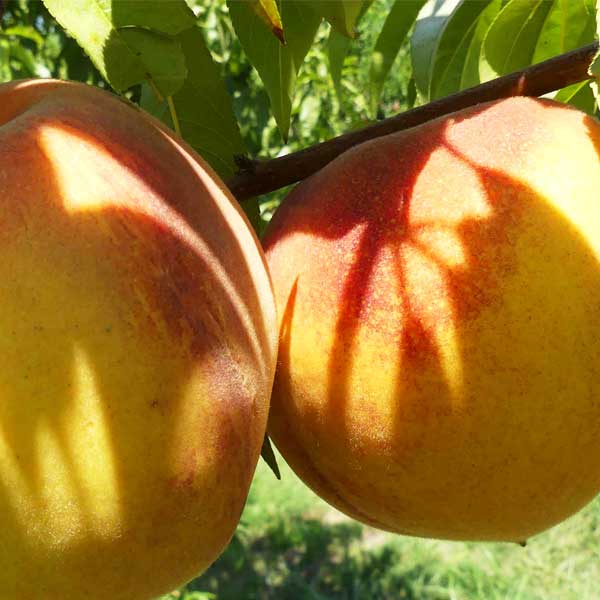
Veteran Peach Tree – (Buy Online)
One of the best peach tree varieties for cold winter growing zones, Veteran Peach (Prunus persica ‘Veteran’) blooms late, past the risk of spring frosts. It’s a reliable producer of delicious yellow freestone peaches. Bakers, take note! This variety is well-known for its wonderful canning qualities. It makes a pretty pie, too. Robust yellow flesh pulls away cleanly from the pit for easy prep. You’ll want to eat your fill fresh from your very own fruit tree.
Veteran is a great choice for your family and friends with this amazing peach variety. The flavor is rich and sweet with full-bodied flesh for a filling mouthfeel. This variety consistently scores well on taste tests. This easy-care variety puts it head and shoulders above other choices, especially for Zone 5 growers at higher altitudes. It even works beautifully for landscapes with cold, wet springs. Pretty, pale pink, double blooms are so welcome after a long winter. Thrill to the developing fruit with its golden-yellow skin touched with a red blush.
Muir Peach Tree
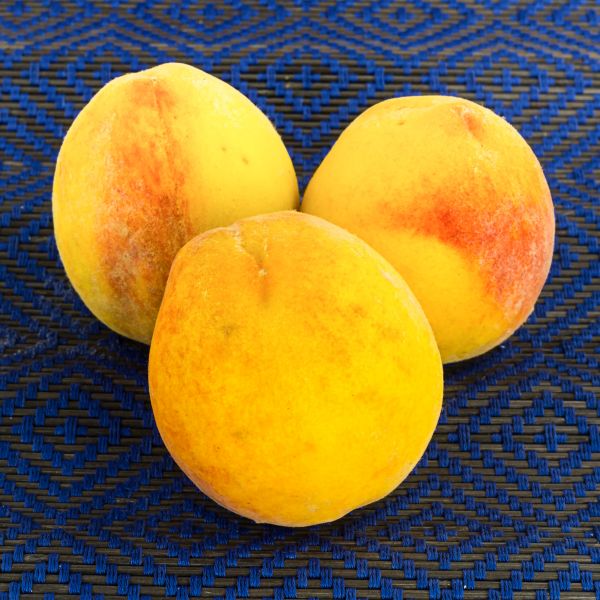
Muir Peach Tree – (Buy Online)
The Muir peach is a superior selection for chefs and foodies who will surely appreciate the thrifty nature of this beloved variety. Other peach tree varieties that are used for drying can take 7 to 9 pounds of fruit to produce 1 pound of finished product. The Muir slashes that average with 4 to 5 pounds of fresh to produce 1 pound of dried product. You likely won’t need to add much sugar to canned fruit. Try them in batches of sugar free preserves.
You’ll love the way the outstanding flavor and sweetness shine through, just as they are. The orange flesh will make a beautiful finished product for you. Muir is fantastic for pies, cobblers, jams, and all other peach preparations. Of course, these are good peaches right off your fruit trees for fresh eating. Try grilling thick slices on your BBQ as a deliciously sweet side dish to savory burgers and steaks.
With dense flesh, it holds up beautifully. If you have never tried it, you don’t know what you are missing! Highly rated, disease-resistant, delicious mid-season fruit, and gorgeous clouds of pretty pink blooms in spring. Order today and start enjoying these wonderful heirloom peaches. Life is good with a few Muir Peach trees in your backyard! How to Use Muir Peach in the LandscapeMuir Peach is self-fruitful, so you’ll get a crop with just one tree. But even self-pollinating trees appreciate having partners nearby.
Canadian Harmony Peach Tree
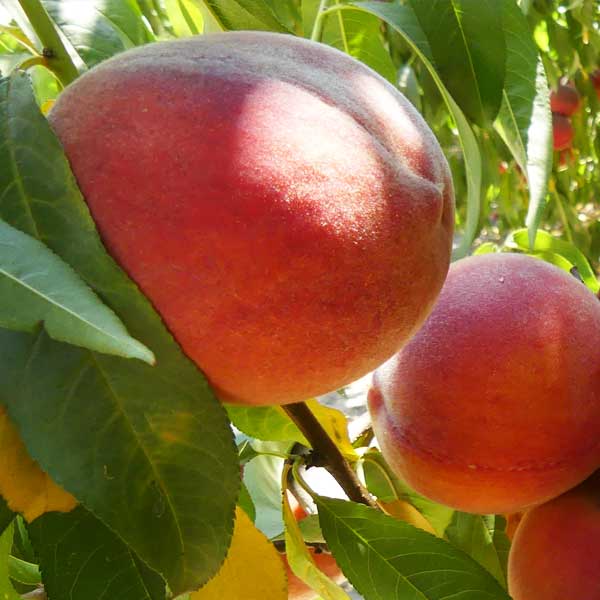
Canadian Harmony Peach Tree – (Buy Online)
If you live in colder areas, The Canadian Harmony Peach tree (Prunus ‘Canadian Harmony’) is a productive and pretty tree. It blooms a bit later than other peach tree varieties, which protects your harvest from those nasty late spring frosts. With a well-balanced flavor, the Canadian Harmony fruit is also very versatile. This is truly an “all-arounder” that can be used for just about anything peach-related.
It’s juicy and very delicious. Enjoy the large, firm peaches fresh or freeze them for use later in the year. The pit pulls away cleanly, which makes preparation smooth and easy. The yellow flesh is firm and displays red near the pit. It doesn’t brown as fast as other peach tree varieties, so it makes a nice presentation on a plate or in salads. It’s also a good keeper. You’ll get a lot of value from these peaches, as they have a long shelf life. With a zippy hint of acidity, this sweet yellow peach stands up to baking. Use it to make amazing pies and cobblers. It cans beautifully and freezes well.
This cold-hardy variety was introduced from Ontario, Canada. It’s tough enough for northern gardens but is also successful across a wide swathe of the United States. It’s a self-pollinating variety, so you will only need one tree. This makes it possible for people with small yards to grow their own fresh fruit. Canadian Harmony has a well-deserved reputation as a good producer.
Rio Oso Gem Peach Tree
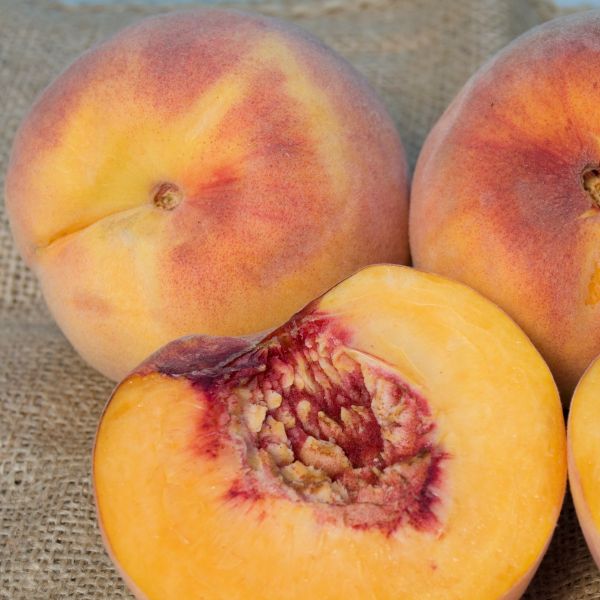
Rio Oso Gem Peach Tree – (Buy Online)
The Rio Oso Gem Peach tree is most beloved for its exceptional fruit. Large and firm, its appearance is as stunning to the eye as its taste is a sensation on the tongue. Round with yellow skin and scarlet blush, your Rio Oso Gem Peach presents a stunning picture hanging amid its vibrant, green foliage. Rio’s flesh is somewhat coarse yet juicy, with a delightfully-rich, sweet flavor with orange undertones and a tart finish.
As if the fruit weren’t reason enough to plant one of these productive trees this year, the spring flowers will provide a burst of pink, floral brilliance in late spring, a lively start to the coming summer. The gorgeous blossoms begin as red buds before opening to prolific, clusters of pink blooms that blanket your tree before transitioning to fruit. When fall arrives, your Rio Oso Gem Peach tree foliage will take on yellow hues for a lovely autumn show.
Rio Oso Gem Peach tree tends to have a low canopy and is adaptable to a variety of soil types. Rio is considered to be self-fertile (so you can start with just one if you prefer), however, it tends toward an improved yield with a pollinator nearby. Its late spring bloom helps it to withstand spring frosts, an added benefit depending upon where you live in the country. Rio Oso Gem Peach is a great choice if you don’t have much room, and want a peach that will be both ornamental and fruitful (and hardy in terms of frosts). It’s even long-lived (living up to 40 years in optimal conditions).
Indian Free Peach Tree
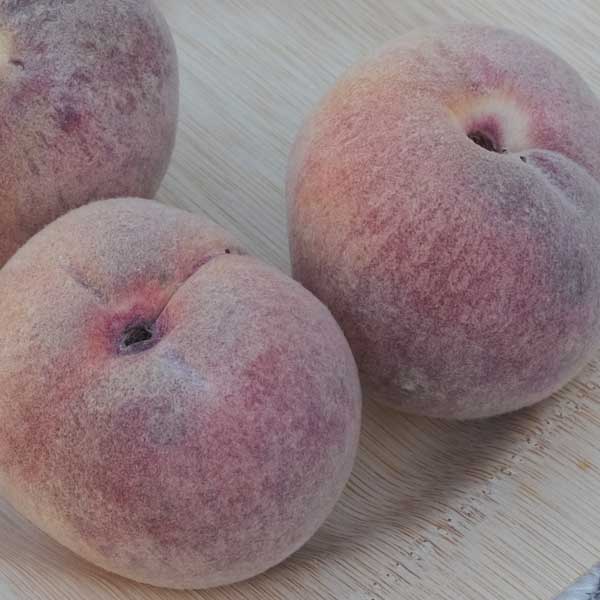
Indian Free Peach Tree – (Buy Online)
The cherished Indian Free Peach (Prunus persica Indian Free’) is a disease-resistant tree that produces large freestone peaches. You’ll have to do a double-take when you see the harvest. These white peaches are marbled with dark, wine-red streaks through the flesh. The streaks radiate from the skin inward and from the pit towards the skin. This makes for a truly striking fruit. Imagine serving grilled slices with artisanal cheese and prosciutto! It’s a marvelous presentation, and all this from your very own fruit tree. You will simply dazzle your family and friends with this amazing peach variety.
The flavor is where the sweet, smooth, and juicy Indian Free Peach really stands out. It’s described as a berry-like flavor with a hint of plum. You’ll begin eating well when the fruit is firm-ripe and enjoy as it continues to improve as it hangs on the tree. The peaches reach a delicious 19 – 20 Brix (sugar rating scale) when fully ripe. Indian Free Peach has won many taste tests time after time. Highest rated, this beautiful heirloom variety has been beloved since its introduction around 1869.
Indian Free is thought to be a sport of the famous Indian Blood Peach, an Old World clingstone variety planted at the Monticello orchards of Thomas Jefferson. Indian Free has a freestone pit, which pulls away cleanly and easily. This makes for easy preparation! Enjoy these rare fruits in a myriad of ways. Indian Free Peach surprises most first-time eaters with its rich, sweet, berry-like flavor.
Reliance Peach Tree
The Reliance Peach, Prunus persica “Reliance”, is one of the most cold-hardy Peach tree varieties tree you can get. We’ve heard, time and again, of this tree producing a heavy fruit load after a frigid northern winter. Developed in New Hampshire, and we strongly recommend it for most areas from Zone 4 down through Zone 8. Self-pollinating, this red-skinned Peach will not only offer beautiful, fragrant flowers in the spring, but fruit by summer and followed it up with pleasing fall color. This tree bears medium-to-large fruit with a sweet, mild flavor. The Reliance Peach tree, after exhibiting beautiful pink flowers in early spring, produces a peach with dark red skin. This is the hardiest yellow-fleshed freestone peach we have. Self-Pollinating Free-Stone Red Peach Fragrant Blooms In Spring Very Cold Hardy Peach!
Belle of Georgia Peach Tree
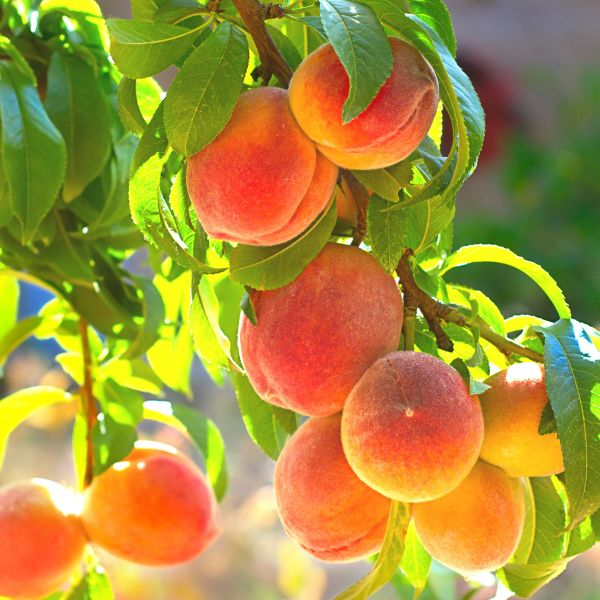
Belle of Georgia Peach Tree – (Buy Online)
Belle of Georgia Peach Tree, Prunus persica, is a fruit-bearing tree with decorative features. Plant one near a front entrance to ensure a beautiful spring display and bountiful fall harvest of delicious fruit. Your Belle of Georgia Peach Trees is more than just a fruit-producing tree. This tree proves that edibles can be both ornamental and delicious! Belle of Georgia produces large, firm fruit with blushed red skins and yellow-cream highlights.
The fruit is sweet and succulent, perfect for eating right off the tree, baking, or canned for winter use. Belle of Georgia Peach Tree is particularly noted for its abundance of pink, springtime blossoms which are sure to transform your yard into a spectacular welcome for the coming summer. With their enchanting color and delicate scent, the flowers are a strong draw to butterflies and other pollinators for your yard.
The summer foliage fills out the tree nicely, making for a delightful shade tree that offers relief for the heat of summer. There are few things as enjoyable as lying under your very own peach tree and gazing at the developing fruit as it dangles amid the branches. The late August harvest ensures you have lots of time enjoying your peaches for their ornamental value long before you even harvest them to partake of their outstanding quality and delicious flavor. Belle of Georgia Peach Trees are hardy trees, disease-resistant, and self-pollinating. This is a tree that will provide you with a large harvest with very little care needed on your part. If you love peaches, this is the tree for you!
Harken Peach Tree
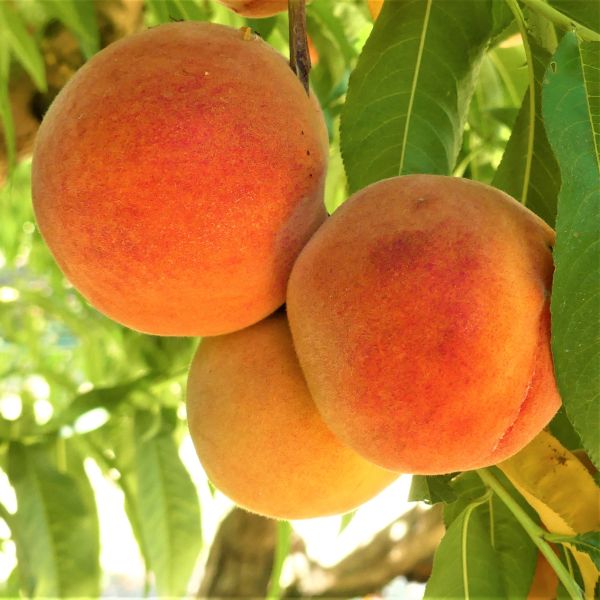
Harken Peach Tree – (Buy Online)
Harken Peach Tree is best known for the superior quality of peach it produces mid-season. Each delightfully fuzzy, large peach has a bright red, yellow-mottled skin. The flesh is yellow, very sweet, and resistant to browning. Harken bears a regular crop of freestone peaches suitable for canning and other uses. However, its favorite use is often eating it right from the tree! For optimal storage, pick fruit before it is table ripe.
The Harken Peach Tree is admired almost as much for its beauty and fragrant blossoms as it is for its fruit. The delicate peach blossoms appear in late winter/early spring along the subtle grey branches, even before the leaves emerge. It’s an exciting beginning to the upcoming harvest. Harken Peach is an extremely vigorous tree and will bear large crops. You can help it along with some pruning, which will encourage new growth and help it to maintain the size you prefer. Harken is self-fruitful, so you can start with just one tree if you like.
Loring Peach Tree
A Loring Peach Tree will charm you with its impressive display of pink and white spring blooms. The scented blossoms will call to pollinators and spin their perfumed web throughout your yard, a fragrant breath of spring that hints of things to come. It won’t take long before you’re treated to the sight of your tiny peaches racing toward harvest. As mid-July approaches, you’ll see your tiny fruit mature into large, yellow peaches, complete with an enchanting, scarlet blush.
Biting into your first peach, fresh off your own tree, will quickly reveal why Loring is a taste test winner. The yellow flesh is juicy yet firm, low in acid, and oh so sweetly delicious! The peaches are wonderful right off the tree or great for canning and freezing. The Loring Peach is a vigorous grower that will adjust to a variety of soils and tolerates heat and humidity. It’s generally an easy tree to care for, requiring little or no trimming and being relatively hardy. Among peach tree choices, Loring is a great variety. It’s easy to care for, provides delicious fruit, and is even ornamental.
Bonita Peach Tree
Bonita Peach trees begin the spring season with petite, pink blossoms that herald the coming harvest with their cheerful display and delicate fragrance. As the summer progresses, the flowers give way to dangling orbs that develop into medium/large peaches with lively, yellow color highlighted by a rosy blush.
The delectable fruit is ready for harvest from late July to early August when the enticing peaches have reached the height of their juicy goodness. Imagine picking one fresh from the tree and biting into the flesh, still warm from the sun’s rays! Bonita is known for having a rich, robust flavor, its taste on your tongue both sweet and subacid when you bite into the firm flesh.
Bonita Peach trees are heat and humidity tolerant and generally easy to care for. Bonita is self-fruitful so you can try just one at first…but it certainly won’t be long until you’ll wish you had several! Bonita Peach is a great choice of a peach tree variety that will provide you with pretty pink flowers in spring and gorgeous, sweet fruit in late July/early August. It’s an attractive and fun way to grow your own healthy fruit right in your own yard. Heat and humidity tolerant Self-fruitful Does well in coastal climates
Kaweah Peach Tree
The Kaweah Peach tree, Prunus persica ‘Kaweah’, was bred in California for the shipping trade. What does that mean for you? It means that one of these great trees in your back yard will give you the same consistently high yields and uniformly large-sized fruits that the best growers in California expect for store-quality fruits.
Kaweah Peaches consistently score high in consumer taste tests with a delicious true peach flavor – the perfect balance of sweet and tart. This is a quintessential all-purpose fruit. It is perfect for eating fresh, but it is also great for baking, canning, jams, and jellies with firm flesh that stands up to those processes well. Amazingly, Kaweah Peach also doesn’t need a long chill time – 500 hours or less – for it to set fruit for the next year. t
Sweet Sensation Columnar Peach Tree
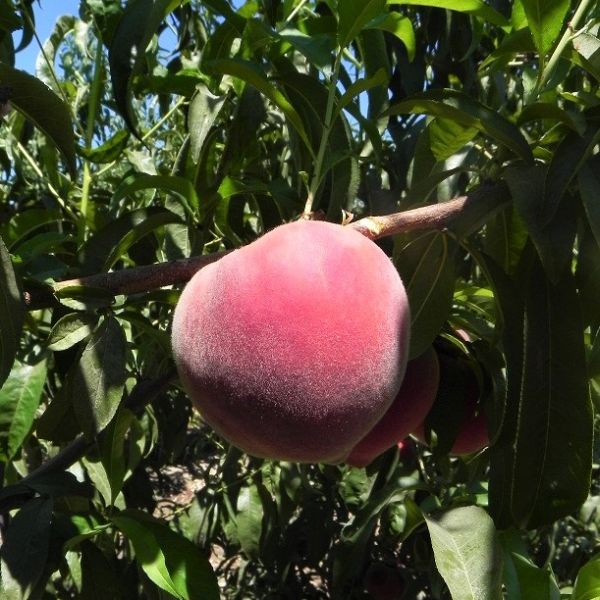
Sweet Sensation Columnar Peach Tree
Sweet Sensation Columnar Peach (Prunus persica Sweet Sensation’) is a perfect example. Why not grow your own succulent peaches, taking full advantage of your land and the sunshine above? With a narrow, columnar variety like Sweet Sensation, it’s easy! This columnar tree won’t get very wide. It’s naturally right-sized but produces large, red-blushed, yellow fruits. Even gardeners on the smallest lots can find a spot to grow healthy and delicious fruit.
Sweet Sensation peaches are highly colored, with bright red skin and juicy, yellow flesh. Nearly fuzz-free, the sweet taste will appeal to even the pickiest eaters. And the freestone pit falls away cleanly to make preparation a snap! The spring flower display is incredible. Anyone would be thrilled to grow a small tree with these lovely pink blooms in spring. Sweet Sensation is truly an ornamental edible plant that works beautifully in several seasons. Even the fruit makes a highly ornamental display.
The bright red skin of a Sweet Sensation peach is pretty as a picture. You’ll love the way your tree looks at harvest time! The flavor of these classic, yellow freestone peaches has a perfect acid and sugar balance. These sophisticated peaches will satisfy foodies but are sweet and juicy enough to keep the kids happy, too. They’ll make fantastic pies, cobblers, and crisps. Try them sliced and grilled for a wonderful side dish. Slice and freeze for a taste of summer during wintertime. Dehydrate them, or add to water to infuse with the incredible flavor.
Salish Summer Peach Tree
The Salish Summer Peach (Prunus persica ‘Q-1-8’) is both delicious and disease resistant. Luscious white flesh will make any homeowner with an edible landscape smile. Salish Summer fruit is very flavorful. It’s well-balanced with just the right amount of acid to bring out the sugar. This white-fleshed variety offers a wonderfully complex flavor. Its sweet, melting flesh is smooth and oh-so-juicy.
A cold hardy, widely adapted selection that seems to handle challenging climates with late freezes. You’ll enjoy a particularly attractive bloom in the spring. Clouds of showy pink flowers cover the branches for a lovely show. Even the fruit is highly ornamental. The skin is light yellow with a red blush on the sunny side of the fruit. Salish Summer fruit is great for fresh eating off the tree. Enjoy the pure white flesh! It looks almost as creamy as the smooth texture tastes. This is the perfect fruit to include in your morning smoothie or pack it in your lunch for a great mid-day snack.
Blushing Pearl Columnar Peach Tree
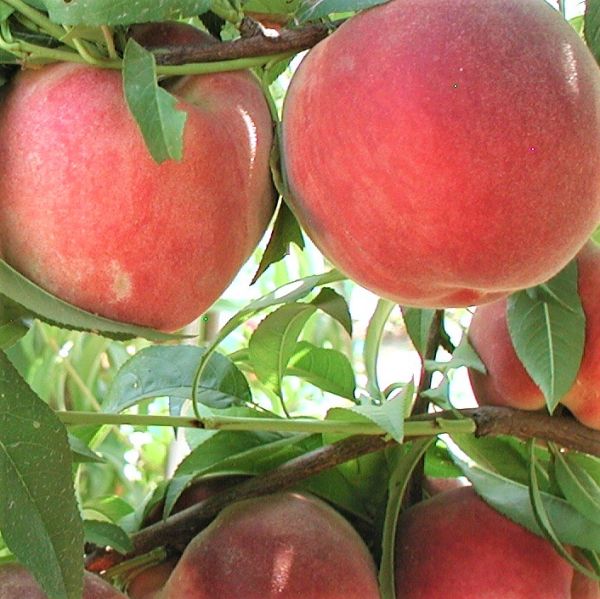
Blushing Pearl Columnar Peach Tree
Blushing Pearl Columnar Peach Tree (Prunus persica var.nucipersica ‘Blushing Pearl’) is a wonderful solution for the modern backyard orchard. It stays extremely narrow and can be maintained at any height you like with simple summer pruning. The peaches are large and so tasty! Blushing Pearl produces white-fleshed fruit with pinkish-red blushed skin. This great selection has an outstanding flavor with just enough acid to bring out the rich, sugary flavor.
Blushing Pearl Peaches make incredible fresh eating fruits, delicious warm from the sun when fresh-picked from your tree. They also make wonderful pies and preserves. Try dehydrating slices for use as a healthy winter snack. The fruit has a good hang time on the tree while it continues to get more flavorful. That makes for a nice, convenient harvest for you and your family.
Blushing Pearl is a pretty tree. You’ll want to feature it as an accent, with its clouds of showy pink blooms in springtime. The developing fruit creates a very attractive display, as well. You’ll even get a beautiful display of yellow fall color. This is a self-fruitful columnar tree, so you’ll get fruit from a single tree. But, you’ll always get more fruit with a partner tree. Buy two or add additional columnar stone fruit trees to increase the size of your harvest.
Pink Halo Peach Tree
Pink Halo Peach (Prunus persica Prunus persica ‘Pink Halo’) makes it easy for you! This low-maintenance, beautiful tree produces amazingly sweet, donut-style peaches with pink flesh. Kids of all ages will love the super-sweet taste. Enjoy clouds of fluffy, pink blooms in springtime with Pink Halo Peach. Flowers and the developing fruit are both very ornamental. You’ll even have a golden fall color show to enjoy.
The excellent pink flesh of the Pink Halo makes a great, mid-season harvest. Scarlet Halo has deeper flesh and ripens a bit later. Talk about a Dream Team! These highly desirable trees are an improvement on the ancient Donut-style Peach trees from the Orient. Beloved for thousands of years, as you might imagine, they have a lot of nicknames. You might hear them called the donut/doughnut peach, saucer peach, UFO peach, hat peach, and bagel peach!
Pink Halo is also very ornamental. Plant this tree near a window where you can enjoy a daily view of your gorgeous fruit as it ripens on the branches. It features an upright form, with showy pink spring blossoms in spring. The flowers bloom before the tree leaves out, to produce a dazzling display. Use a single tree as an outstanding specimen in a mulched patio planting. Or, pair it with Scarlet Halo, and plant them on either side of your front yard.
While it is adapted to a wide range of soil types and climates within USDA zones 6-9, the soil must be well-drained. If you have heavy clay soil, or soil that doesn’t drain well, plant in a raised bed, or create a mound of soil heaped 12 – 18 inches tall by 3 feet wide.
Early Elberta Peach Tree
Early Elberta (Prunus persica ‘Early Elberta) is a great-tasting mid-season treat. The trees, originally a sport of Elberta, are big producers, so you’ll have plenty on hand to share and enjoy. We’re talking up to 150 pounds on a single, self-pollinating tree. The tree produces fruit that is yellow-skinned fruit with a slight red blush. It ripens about two weeks earlier than Elberta. Add one of each to your edible landscape and enjoy a month of harvest. Extend the fresh eating season even further with a Fay Elberta tree. Make Clara Elberta (the original namesake) proud.
Get started on your food security with one of the best of the best. This tree grows well in a wide variety of climates across the country. After all, Early Elberta has been a favorite for well over 100 years. Order yours today!#ProPlantTips for CareGive Peach trees at least 6 hours of direct sunlight a day.
Vivid Peach Tree
The Vivid Peach Tree (Prunus persica ‘Vivid’) features a fully red-blushed skin. Spectacular spring blooms, along with the eye-catching fruit and good fall color make this choice a true “ornamental edible”.But this one isn’t just a pretty face. These peaches also deliver a luscious and juicy fresh eating experience. Vivid is a good “all-around” peach with high-quality taste. Fans call it “the perfect peach” for good reason.
You can use the fruits as an excellent fresh-eating peach, or in homemade preserves, pies and cobblers. Their freestone pits pull away cleanly from the flesh for easy preparation. You’ll love how productive Vivid Peach trees are. These reliable producers are easy-care and self-pollinating. Add Vivid Peach trees to your landscape this season.
Fay Elberta Peach Tree
Fay Elberta has a full-bodied flavor, with a balanced mix of sugars and acids. It is well suited for the complexity of savory meat sauces for pork, steak, and chicken. Try them on the grill, add them to salads and elevate the humble grilled cheese sandwich. Fay Elberta is a gourmand’s best friend. Heritage Elberta-style trees have earned a special place in the heart American backyard peach fruit culture. And they are self-pollinating, so you’ll get a harvest with a single tree. If you have the room, why not add Early Elberta, Elberta, and Fay Elberta varieties to extend your season for a month or more? Fay ripens after Elberta. In fact, it is also known as Late Elberta. This tree grows well in a wide variety of climates across the country. These popular trees are big producers, so you’ll have plenty on hand to share and enjoy.
Elberta Peach Tree
The Elberta Peach (Prunus persica ‘Elberta’) is the original Georgia Peach! Since its introduction in 1889, the Elberta peach has a long history of being one of the finest peaches grown. Over the years, it’s become the most planted peach variety in the United States. Today, the Elberta peach remains the most popular home garden variety available.
The Elberta is one of the finest fresh eating peaches. Firm flesh and incredible flavor are the hallmarks of the Elberta peach. As well, the enormous production of this wonderful peach makes it a highly valuable tree. You’ll love having continual large crops of this delicious fruit every year. The Elberta Peach is a wonderful choice for cooking and baking. A peach pie never tastes any better than when made with Elberta peaches.
This is also a great canning variety because the freestone makes prepping go faster, and the fruit is nice and firm. You’ll get thick, meaty slices that can be dried or dehydrated as a fantastic snack. The wide adaptability of this classic peach is another fine quality. Plant in zones 5 through 9 in good draining soil. The Elberta Peach can be easily maintained at any height with pruning. Plan on keeping it below 8 feet so you can easily maintain the tree while enjoying a “ladder-free” harvest of your crop.
The self-fruitful Elberta is also a top choice for espaliering flat to a sturdy trellis. Elberta ripens in the early-late season. You’ll likely harvest in September, although some areas come on a little earlier in August. Though self-fruitful, consider planting another early or late selection to extend your harvest period to 3 months. Give the Elberta a well-deserved spot in your home garden orchard.
Bonfire Peach Tree
The Bonfire Peach tree (Prunus persica ‘Bonfire’)! In a very small space, you get access to a wonderful patio peach tree with simply outstanding ornamental features. You’ll love this petite tree all year long. From its lovely form in winter, to the impossibly pink flowers in spring, to its sweet, fuzzy peach orbs to the deliciously deep foliage – this tree has it all!
Bonfire is a very popular ornamental peach tree or deciduous shrub. This valuable plant that can be used in the ground, or an excellent container plant for your patio. It produces pretty peaches that can be canned or baked into delicious desserts. The fruit is white-fleshed with red striations. The flesh turns red when cooked and will add a lovely color contrast to baked goods. The ornamental qualities of the Bonfire can’t be overstated.
In early spring, vibrant blooms burst forth into striking, bright double pink flowers with deep pink centers. The flowers liberally frost the branches in dynamic color. The effect is stunning in any landscape and sure to turn the heads of friends and neighbors. The ornamental value of the Bonfire Peach continues into the spring and summer.
After flowering, the summer foliage emerges with shiny, long, dark red leaves. Cute little peaches start to develop along the branches. Kids would absolutely love watching this sweet little tree! They’ll eagerly await their turn in the kitchen helping make (and eat!) peach pie or cobbler in late summer or early fall. Gradually this dramatic foliage turns to a deep burgundy which remains until leaf drop in the fall. Even in winter, the elegant form of this tree captures attention
.Bonfire Peach is a one-of-a-kind peach tree with a 4-season appeal, and sure to be a valued addition to your home. Order yours today! How to Use Bonfire Peach Tree in the LandscapeUse this pretty peach as a lovely companion to other plants in your shrub border or as an accent in a perennial bed. The Bonfire Peach is also an excellent choice as a container plant for your patio. Or, for the more adventurous, try a pair of them on either side of your front door.
Crimson Rocket Peach Tree
Crimson Rocket Peach Tree, Prunus persica ‘Crimson Rocket™, is perfectly sized for urban gardens, patio containers, and balcony planters. Crimson Rocket™ has a much tighter profile, but the same great yields as bigger types of Peach trees. And they don’t need a pollinator! One tree will produce armloads of big, sweet, juicy Peaches – plenty to keep for pies, preserves, and fresh eating and plenty to give away to the neighbors!
They will give you their first crop one to two years after planting and grow 1-2 feet per year. The easy to grow Peaches are firm, large, and freestone and ripen early in the season. The trees are small enough that you could have your own urban orchard of Crimson Rocket™ Peach trees. Farmer’s Market here we come! Great for the beginning hobby orchardist and seasoned fruit growers alike, these small, columnar (not dwarf) trees will give you years of full-sized, juicy, Peaches with ease. Imagine picking them from your patio, your kitchen garden, or your balcony.
O’Henry Peach Tree
O’Henry was considered a breakthrough in the commercial marketplace. With ripe fruit that was almost entirely red, it was a standout from the yellow and blushed red common commercial peach tree varieties of the time. It also featured an almost fuzz-less skin and a sweet taste when the fruit is still firm. This crunchy, sweet flavor of the O’Henry peach was an exciting treat for both fresh eating and storage. No wonder demand for this variety soared into the wildly popular demand that continues today.
A strong, vigorous, heavy-bearing and self-fruitful tree, the O’Henry Peach is often selected for its durability. Because of Its firmness, the fruit is an excellent choice for long-term storage. O’Henry Peaches are large, firm, and only slightly fuzzy compared to other peach tree varieties, ready for harvest late in the season. Even the outer appearance of this peach is marvelous, an exquisite contrast to the green foliage as the ruby-red globes dangle among the branches. Overall, the O’Henry Peach is a tasty, high-quality, and reliable peach with just a hint of vanilla.
By the 1980s, the O’Henry was planted throughout the West and Northwest with a high degree of success and can be found at Farmer’s Markets regularly. O’Henry PeachesCharacterized by yellow-fleshed, semi-freestone fruit streaked with red hues, these peaches are as sweet and juicy as you could expect them to be. O’Henry Peaches are perfect for eating right off of your tree, while they’re still warm from the sun’s rays. They also keep quite well on the kitchen counter. . . or if you prefer, they can be canned, dehydrated—even frozen for future use.
White Lady Peach Tree
The White Lady Peach tree is among the best of the new low acid, high sugar, white peaches. The aroma is heavenly and the flavor sublime. In fact, it was one of the top-scoring varieties at a blind fruit tasting event. The red-skinned peaches, with cream flesh, are medium to large, very firm, and freestone.
By late July you’ll be ready to harvest these delectable delights. Eat them fresh off the tree or save some for later. They have good storage and shipping qualities, so you don’t have to worry about them spoiling before you can use them all. Aside from its superior fruit, White Lady Peach produces stunningly beautiful pink flowers making it a spring ornamental tree along with its fruit-bearing capabilities! There’s nothing like a peach tree right outside your window. From spring until fall, it’s a delight to behold.
Donut Peach Tree
Grow your own Donut Peach tree (Prunus persica ‘Donut’) to really experience the amazing tree-ripe flavor of this special fruit. This wonderful fruit is a fun novelty, but the taste is nothing short of outstanding. Well known in China for over 1000 years, the skin of a Donut Peach is red over a light yellow with light fuzz. The flattened fruit is the perfect eating size. Its sweet, juicy, and white-fleshed. Kids love the taste and the fun shape.
It’s mild, and less acidic than other peach selections and has a faintly almond taste. As you can imagine, this variety of white-fleshed fruit was known by any number of different names. Donut™ Peach or Stark Saturn (Also known as Peento, Saucer, Pan tao, Saturn Peach, or Doughnut) are distinctively shaped white peaches that would finally find its way to the United States in about 1871. It has a doughnut-shaped “flat” fruit with a sunken center and plump outer edge.
It is just as wide as the most common peach tree varieties but is flatter than other peach selections. Its juicy, white flesh is mild flavored. It has a clingstone pit in the sunken center shaped like a doughnut. Because this is a flat Peach, you can easily eat all around the pit. In fact—you can almost snap the ripe fruit in half while prepping. This exposes the pit, which can then be easily removed.
Donut Peach fruit trees are reliable and known for dependable yields from a young tree. This is a variety that works in both low and high chill climates. Donut Peach requires an estimated 400-500 hours of chilling, but it will still produce well in the colder areas of Zones 5-8. Donut Peach is an improved early blooming variety. With careful selection, these trees are bred to have more frost tolerant blooms which should make it through the occasional late spring frost. Give it a sheltered spot in Zones 5 and 6.
Redhaven Peach Tree
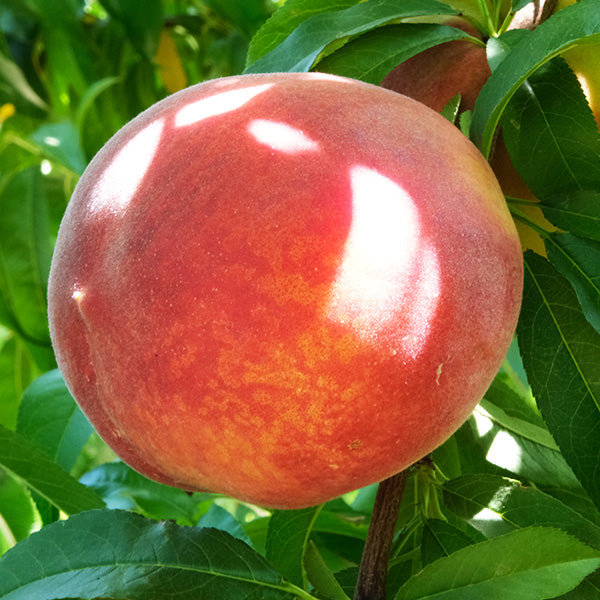
Redhaven Peach Tree – (Buy Online)
The Redhaven Peach (Prunus persica ‘Redhaven’) is the peach by which all others are measured. Generations of growers have appreciated it’s reliable, heavy-bearing nature. And the fruit? It’s beautiful, with hardly any fuzz, blushed with red, and opens to sweet, creamy yellow flesh. Completely luscious!Great for fresh eating, baking, canning, and freezing.
This peach has a freestone pit, so it’s easy to process them for your family to enjoy over the winter. The pit pulls away from the fruit easily, which is great. You’ll want to savor every bit of that delicious peach! As a big bonus, it’s also absolutely beautiful in spring, with fragrant pink flowers after the worst of the winter weather is past.
It shines as an autumn time accent when it’s leaves turn harvest gold. Plant two for the best crop, or match with another peach variety. It is self-pollinating, but peaches love a partner tree. The Redhaven Peach Tree has strong branches, and it’s resistant to leaf spot, which makes this peach tree a great choice for newbie and expert edible gardeners alike.


